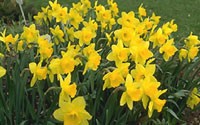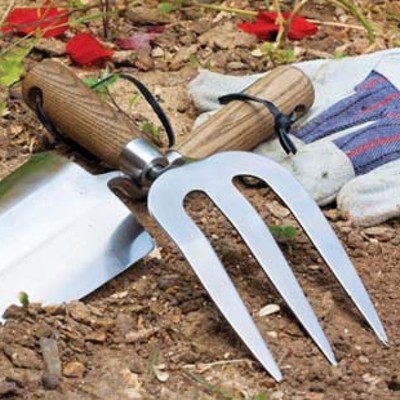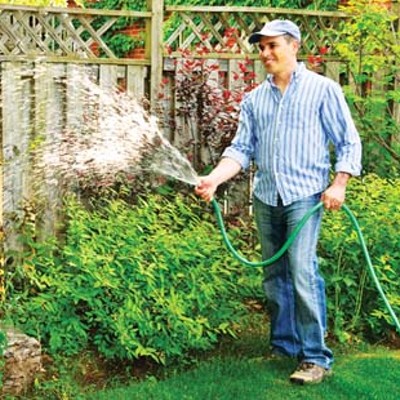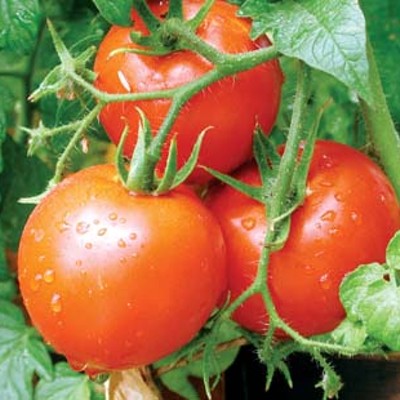You say narcissus, I say daffodil. No matter which name you use to refer to this plant, most gardeners would agree that daffodils are one of the most vigorous and colorful flowers of spring. Daffodil is the common name, while narcissus is the Latin or botanical name for the genus. Jonquil refers to a specific kind of narcissus and is not correct for the group in general. True jonquils usually have several very fragrant flower heads to a stem.
Currently there are more than 13,000 daffodil hybrids; some flower as early as February and some as late as May. They come in all colors and sizes: Yellow, orange, white, green, pink, red, and bicolors, with sizes ranging from 5-inch blooms on 2-foot stems to miniature half-inch blooms on 2-inch stems. There may be one or several flowers to a stalk, and the flowers may be single- or double-petaled. Some are fragrant. The trumpet may be long and tubular or short and cuplike.
Daffodils are probably the easiest and most dependable blooming flowers. Once established, they generally thrive for many years and often spread to produce larger clumps by producing small bulbs. If the bulbs get too crowded, the clumps can be lifted as the foliage fades, divided into smaller clumps, and replanted.
So why talk about daffodils in September? Now through October is bulb planting time. Plant daffodil bulbs in a moist, well-drained soil. Generally large masses of a single color give more show than scattered plantings or mixed colors. Plant in groups rather than straight lines. Avoid planting at the front of a garden bed. A row of summer annuals or perennials placed in front of daffodils will hide the bulbs' foliage as the plant matures.
Daffodil bulbs typically range in price from 30 cents to $3 per bulb, depending on the scarcity of the cultivar. Generally the bigger the bulb the more expensive, but the greater the flower show. Bulbs may be purchased from mail-order garden catalogs, garden centers, or department stores.
Next week's column will contain more in-depth planting information on daffodils and other bulb selections. For more information about daffodils, visit the American Daffodil Society's Web site at www.daffodilusa.org/index.html, or the University of Illinois Extension's "Bulbs and More" Web site at www.urbanext.uiuc.edu/bulbs/index.html.
Why didn't my daffodils bloom last spring?
There are numerous reasons why daffodils might not bloom. Here is a checklist:
Bulbs have not been fertilized in a couple of years.
Bulbs have been fed with a high-nitrogen fertilizer, encouraging the production of leaves.
Daffodils need at least a half-day of sun.
They are competing with other plants for food.
Bulbs are planted in an area with poor drainage.
Plant leaves were cut too soon the previous year.
The bulbs may have a virus. They need to be divided.
Garlic planting time
GarlicÑa member of the onion familyÑis valued for both its culinary and medicinal attributes. Mid-September through mid-October is garlic-planting timeÑat least one month before the soil freezes. The bulbs can root and begin to sprout before the cold weather and continue to grow in the next season. "Seed bulbs" should be large, smooth, fresh, and free of disease.
Garlic grows best in loose loam soils that are fertile and high in organic matter. To prepare the soil, apply 3 pounds of 10-10-10 fertilizer per 100 square feet at planting time, or use organic fertilizers such as blood meal. Compost or other organic matter can also be incorporated into the soil.
A garlic bulb is made up of several cloves. Garlic is started by planting individual cloves that have been separated from the bulb just before planting. Plant cloves three- to five-inches apart with points up and cover to a depth of one- to two-inches. Allow 18- to 30-inches between rows, or, if using raised beds, plant cloves five-inches apart in all directions. Mulch with straw after planting.
Planting your own garlic will reward you tenfold. For more information on growing garlic, visit the University of Minnesota Extension Service Web site at www.extension.umn.edu/distribution/cropsystems/DC7317.html.




















